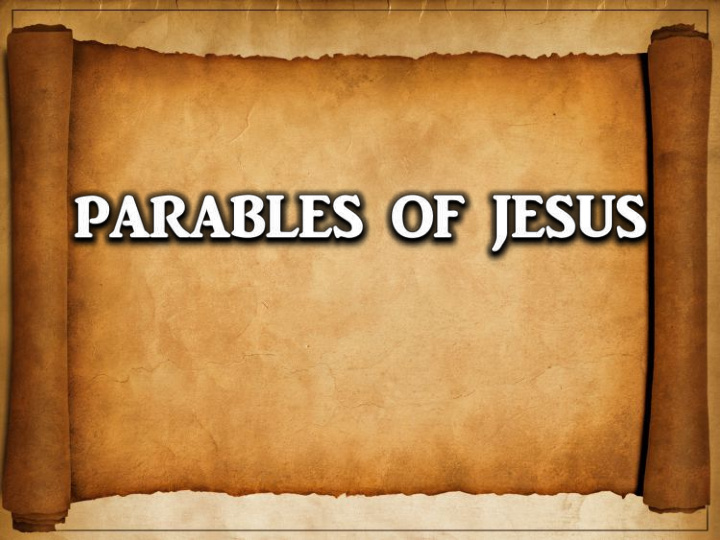



The teaching technique of parables was • common in ancient times. When Jesus taught with parables, He was • employing a technique which was common for His audience. Many of those who heard Jesus teach were • illiterate. Story telling made spiritual lessons of Christ understandable and real.
A parable is a “parallel story.” They were • stories used by Jesus to teach spiritual lessons. The Lord typically chose things with which • the people were familiar and used those things to teach spiritual lessons. God understood the human need to visualize • His truth. This is why He sent Jesus to live and teach among men. It is why Jesus constantly taught in parables.
Jesus used around 40 parables in His • ministry. The themes of these parables include money, • the kingdom of God, forgiveness, judgment, and prayer.
Why did Jesus use parables? • And the disciples came and said to Him, • “Why do You speak to them in parables?” - Matthew 13:10
Why did Jesus use parables? • And the disciples came and said to Him, • “Why do You speak to them in parables?” - Matthew 13:10 Jesus answered them, “To you it has been • granted to know the mysteries of the kingdom of heaven, but to them it has not been granted.” - Matthew 13:11
Through means of parables, some people • would understand the Lord’s message and others would not. When Jesus taught the people in parables, • His disciples understood the message, while it was hidden from His enemies.
Someone asks, “Didn’t Jesus want everyone • to understand His message?” Of course He did! But remember the enemies • of Jesus were determined to put Him to death. The more they understood about the Lord’s • teaching, the sooner they would try to put Him to death.
It was not yet time for Jesus to die. So, the • parables actually hid the message of Jesus from those who plotted to kill Him. The message of the parables was hidden, • not because they could not understand, but because they had hardened their hearts against His word (Matthew 13:13-16).
Nathan (2 Samuel 12:1-4) • The wise woman of Tekoa (2 Samuel 14:6-8) • The vineyard which did not thrive despite • constantly being cared for (Isaiah 5:1-6)
“All these things Jesus spoke to the crowds • in parables, and He did not speak to them without a parable. This was to fulfill what was spoken through the prophet: “I will open My mouth in parables; I will utter things hidden since the foundation of the world.” - Matthew 13:34-35
“With many such parables He was speaking • the word to them, so far as they were able to hear it; and He did not speak to them without a parable; but He was explaining everything privately to His own disciples.” - Mark 4:33-34
The Good Samaritan (Luke 10:30-37) • The Prodigal Son (Luke 15:11-32) • The Sower (Matthew 13:1-9, 18-23) • The Unmerciful Servant (Matthew 18:21-35) • The Persistent Widow (Luke 18:1-8) •
Many of the parables Jesus told were about • the kingdom of God. This would be a kingdom that the Lord would • establish through His redemptive work. The Jews were looking for the Messiah to • establish a physical kingdom. They were looking for the wrong thing! Jesus • came to establish a spiritual kingdom.
In the parables, Jesus taught His disciples • about the establishment and growth of the kingdom. He also taught them about the kind of people • the citizens in the kingdom should be. Since the kingdom He was going to establish • would be a spiritual kingdom, we should not be surprised to learn that the parables He taught were designed to teach spiritual lessons.
The enemies of Jesus did not like the idea of • a spiritual kingdom. They wanted a physical kingdom with a • Messiah who would be a great military leader and overthrow the Romans. Since Jesus was not that kind of King, many • of them hated and rejected Him!
Matthew 13:24-30 •
Matthew 13:24-30 • Tares are weeds that look like wheat, but • their grain is not edible. After the good man sowed wheat in his field, • an enemy came and sowed tares in the good man’s field. Both plants grew side by side in the field • under the time of harvest. At the harvest, the tares were separated from the wheat and burned.
The disciples wanted to know what the • parable meant (Matthew 13:36-43).
The disciples wanted to know what the • parable meant (Matthew 13:36-43). The field in the parable represents the world; • the good seeds are God’s children; the tares are Satan’s children. The enemy who sowed the tares is the devil. • At the end of the world, the angels of God will reap both the tares and the wheat. The wheat will be saved and the tares will be destroyed.
This parable shows us how good people and • evil people exist side by side in our present world. At the end of the world, they will be • separated. The evil people will be lost and the righteous will be saved. Which group will you be in? Will you be a • wheat, or a tare?
Avoid two extremes! •
Avoid two extremes! •
Avoid two extremes! • Don’t try to make something out of every • small detail given in the parables.
Avoid two extremes! • Don’t try to make something out of every • small detail given in the parables. Don’t assume that there is only ONE lesson • to be learn from each parable.
Carefully study the context. •
Carefully study the context. • What do the characters and symbols • represent?
Carefully study the context. • What do the characters and symbols • represent? What is the meaning? •
Recommend
More recommend